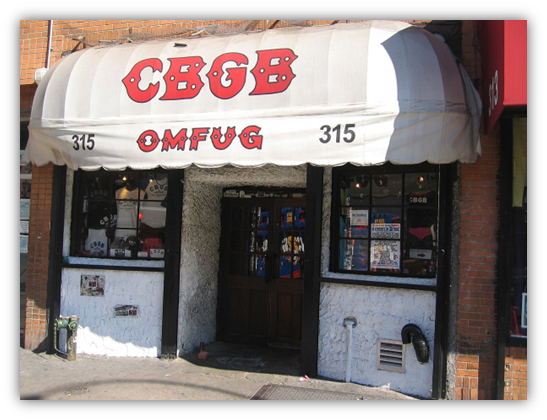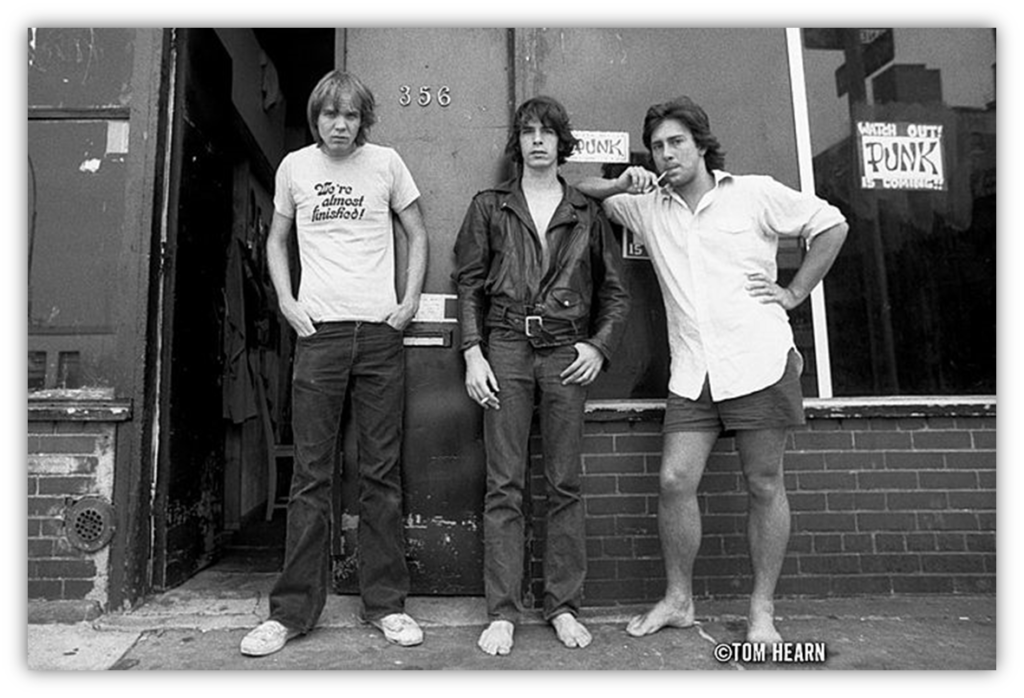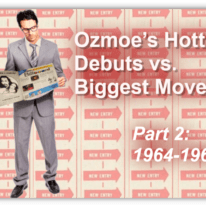Bill Bois’ Music Theory For Non-Musicians™
…if there was ever an art where breaking the rules is one of the rules, it’s music.
REDDITOR R/COMPRIMENS
S3:E10 – What Makes Punk, Punk? – Part 1
When you think country, bluegrass, blues, and other music for uplifting gormandizers, what comes to mind?
If you’re not already familiar with a particular acronym, you probably don’t know who Hilly Kristal was either.

Kristal was a former marine, had pursued both opera and folk as a singer, and worked behind the scenes at the Village Vanguard, the famous jazz venue in Greenwich Village.
At some point he decided he was better at the business side of things rather than on the stage, and opened his own club called Hilly’s On 9th Street in 1966. Pre-fame Bette Midler was one of the regular performers there.
It was successful enough that he started a second club called Hilly’s On West 13th Street.
And then he looked around for a third location.
The late 1960s and early 70s wasn’t a good time for New York City.
Broke and crime-ridden, it let its worst neighborhoods get even worse.

The Bowery had always been a very rough area on Manhattan’s lower east side. It was a place for people who had hit rock bottom.
Drunks, drug addicts, and other down-on-their-luck people lived there, to the extent that you can call it living.
The Bowery’s streets were lined with gambling dens, brothels, and flophouses.
One such flophouse called The Palace Hotel was located at 315 Broadway. It had a bar on the first floor, The Palace Bar, that had a steady clientele of alcoholics who would line up outside each morning before opening, waiting for their pick-me-up drinks.
Property values were, obviously, really low. And cheap housing attracts artists. Art doesn’t pay much so young artists end up living in dangerous places.
Kristal was observant enough to know two things. First, there were muggers in the area but they would go after the easy targets, the drunks who were in no condition to fight back. Second, if the artists were in the neighborhood already, there would be musicians there, too, and they’d need a place to perform.

He rented The Palace Bar in 1969 for $600 a month.
He first renamed it “Hilly’s On The Bowery” and tried to make it similar to his other clubs. But it still attracted the same drunks as before.
Something had to change.
In 1973, he rebranded it with the initials of his intentions: Country, BlueGrass, Blues and Other Music For Uplifting Gormandizers.
That’s all it said on the awning over the door. CBGB OMFUG.

Kristal booked bands with the understanding that they could only do original music. Genre didn’t matter, despite the initials over the door. He wanted real artists. (The only other all-originals rock club in New York was Max’s Kansas City.)
Build it, as the saying goes, and they will come. Kristal was right, there were already musicians in the neighborhood, but who were they?
The bands that eventually played at CBGB’s were pretty diverse, but they had a couple things in common.
They may or may not have been from New York originally, but listened to some of the same records from the late 60s – records that may not have been popular at the time but have become legendary since.
“It seemed like a lot of the people who started the early both punk and new wave bands in America were the only Stooges fan in their town; the only Velvet Underground fan.
And then we all moved to bigger towns and met each other and started bands.”
Jello Biafra, singer for the Dead Kennedys

The Stooges, also known as Iggy Pop & The Stooges, were a fiery live act from Detroit and had released three albums between 1969 and 1973. The first was self-titled and peaked at #106 on the Billboard 200. The third, Raw Power, got only as high as #182. The middle album, Fun House, didn’t chart at all.
Still, their free-spirited freak outs influenced punk and metal musicians alike.
The MC5, also from Detroit, had a similar career and effect.
Velvet Underground were a band that Andy Warhol managed like another one of his art projects. It included songwriter and deadpan street poet Lou Reed, guitarist Sterling Morrison, classically trained Welsh multi-instrumentalist John Cale, and Maureen Tucker, a percussionist with no experience whatsoever who played her bass drum sideways and didn’t use cymbals. Warhol insisted that a German model and singer called Nico be included on the first album. It was called The Velvet Underground and Nico.

This lineup created a debut album as varied as their backgrounds. It ranged from the lovely Sunday Morning to the experimental Venus In Furs to the soft/loud roller coaster of Heroin. Reed’s lyrics talked about the lives of people no one else cared about.
Like folks who might drink at The Palace Bar.
The topics, the poor recording, and the wide ground the album covered stylistically probably prevented it from being more popular. It didn’t help that it was released, withdrawn, and released again due to a threatened lawsuit.
The back cover showed the band performing in front of a screen with the projected image of actor Eric Emerson from one of Warhol’s films.

Emerson, who was short on money after a drug arrest, said he should be compensated for the unauthorized use of his image.
The record label, Verve, recalled the album from stores and re-released it with a black sticker over the photo.
In subsequent releases, Emerson’s face was blurred out. He was paid no money.
Whatever the reason, the album didn’t sell well, but as musician Brian Eno famously said, “…everyone who bought one of those 30,000 copies started a band.”
“You have entire bands that gave us twenty album canons that are all wonderful, but came from one song on this Velvet’s record.
If you look at each song on the Velvet Underground’s debut album, you can measure entire genres being created by an individual song on that record.
Not just bands, but entire genres.”
Music critic Jim DeRogatis
DeRogatis says that
- Sunday Morning led to Radiohead
- Venus In Furs led to Siouxsie & The Banshees and goth in general
- Run Run Run gave us shoegaze
- European Son gave us noise rock
- I’ll Be Your Mirror gave us slowcore
…and the list goes on.
Any band that makes alternative or underground music since 1968 was influenced by The Velvet Underground and Nico – even if they’ve never heard it.
They’ve heard bands that have. Or as Lester Bangs said:

“All modern music begins with the Velvet Underground.”
Velvet Underground’s various styles told musicians to follow whatever direction suited them. The Stooges’ raw power gave bands the right to rock hard without worrying about virtuosity. And that’s what the bands that started playing at CBGB had in common.
The Dictators sounded nothing like Blondie who sounded nothing like The Ramones who sounded nothing like Television who sounded nothing like The Patti Smith Group who sounded nothing like Talking Heads. They all started playing at CBGB in 1974 or 75, and they gave originality more importance than execution.
And that’s what punk was before it had a name.

It was making the music you wanted to make without worrying about trends or other people’s opinions.
Diversity is as beautiful as beauty is diverse.
So. What happened?
How did that hodgepodge of sounds become a single genre?
Before the word “punk” was used to describe the scene at CBGB, it had a few other meanings, none of them good. As an adjective, it meant being in poor health or otherwise inferior. As nouns, it meant wood that was too decayed to use for anything other than burning, or a novice, or a hoodlum, or a young man used for sex, especially in prison.

Yet when artist John Holmstrom and writers Legs McNeil and Ged Dunn, Jr. had the idea to start a music magazine like Creem or Rolling Stone but with cartoons, they decided to call it Punk.
It was about celebrating the ostracized.
Photo Credit: Tom Ahern
Holmstrom and McNeil went to CBGB to see The Ramones, and Lou Reed was in the audience. They approached him and said they wanted to interview him for their magazine and would put him on the cover. Reed dryly replied, “Your circulation must be fabulous.”

The first issue had the Reed interview, a feature on Marlon Brando (“The Original Punk”), a Ramones centerfold, and a sort of editorial declaring “Death to Disco Shit.”
Though the editorial was negative about disco, it had the effect of pulling together the punk scene.
It’s easier to have an “us” when there’s a “them.”.
The mainstream music press, if they mentioned this downtown scene at all, took to calling it “punk rock.”
That lumped all those bands that sounded nothing like each other into the same new catchphrase. The bands didn’t really like being called punk or even being treated as working in the same genre, because they weren’t.
What held them together was their idea that music didn’t have to be sanctioned by major labels or the press to be good. Musicians didn’t have to be trained, classically or otherwise, to create something interesting. Songwriting should be back to basics, but smart and poetic.
However, a genre with a threatening sounding name sold newspapers, and that was especially true in London.
Where the tabloid press had a field day with The Sex Pistols.
A clothing shop in London became the epicenter for the burgeoning punk fad.

The shop, called SEX, was co-owned by designer Vivienne Westwood and provocateur Malcolm MacLaren. Westwood and McLaren visited New York and worked a deal to supply The New York Dolls with stage clothes.
That was fine for an European tour, but McLaren wanted something shocking to get attention. He thought that the Americans hate nothing more than communism. So he dressed the Dolls in red patent leather and used the hammer and sickle as a stage backdrop. This was just as glam rock was fading out anyway, and the shock tactic backfired. Guitarist Johnny Thunders blamed McLaren for the band’s breakup.
While in New York, Westwood and McLaren had been to CBGB and saw Richard Hell & The Voidoids perform. Hell wore a shirt held together with safety pins because he couldn’t afford new clothes.

Soon, SEX was selling clothing with safety pins. It became a fashion statement, along with bondage trousers, spiked mohawk hairstyles, and leather motorcycle jackets like The Ramones wore.
Some people put safety pins through their cheeks. In the UK, punk was a fashion statement first, a music genre second. The tabloid press was more than happy to put this “deviant” look on its covers.
The British punk bands, however, were something to behold, no matter what they wore. The Clash, Generation X, Siouxsie And The Banshees, The Damned, The Slits, X-Ray Spex all had their own sound, but were much more similar to each other than the bands in New York. That’s probably because the musicians knew each other and had already played in previous bands with each other.
Chrissy Hynde, for instance, not only worked at SEX, she had been in an early version of The Damned, an early version of The Clash, and bands called The Unusuals, Johnny Moped, The Moors Murderers, and others.

When her visa was about to expire, two members of The Sex Pistols agreed to marry her so she could stay.
All that before she started The Pretenders.
The Sex Pistols exemplified the English punk sound. Much like The Ramones, they stripped rock & roll down to eighth note downstrokes and power chords.
Where most chords are triads, meaning they have three notes, power chords have only two. A major triad has the root note, the third note up the scale, and the fifth note. A power chord has only the root and the fifth. Players might play the octave up from the root, too.
So: the notes in a C major chord are: C, E, and G.

In the power chord version, it’s just C and G. Power chords are neither major or minor.
They’re also really easy to play.
Many punk bands used power chords – but could be more sophisticated.
We’ll get to all of that next week. This is only the beginning.
Suggested Listening – Full YouTube Playlist

Femme Fatale
Velvet Underground & Nico
1967

I Wanna Be Your Dog
The Stooges
1969

Personality Crisis
New York Dolls
1973

(I Live For) Cars And Girls
The Dictators
1975

Gloria
Patti Smith Group
1975

Blitzkrieg Bop
The Ramones
1976

X Offender
Blondie
1976

New Rose
The Damned
1976

Max’s Kansas City
Wayne County & The Backstreet Boys
1976

Anarchy In The UK
The Sex Pistols
1977

Blank Generation
Richard Hell & The Voidoids
1977

See No Evil
Television
1977

Love Goes To Building On Fire
Talking Heads
1977

Complete Control
The Clash
1977

Oh Bondage Up Yours!
X-Ray Spex
1977

Your Generation
Generation X
1977

Gary Gilmore’s Eyes
The Adverts
1977
(Let the author know that your liked their article with a “Heart Upvote!”)





No sooner do I mention Television than word comes that Tom Verlaine has passed away.
https://www.stereogum.com/2212018/televisions-tom-verlaine-dead-at-73/news/
Please find some time this weekend to listen to the Marquee Moon album in its entirety.
Mega bummer!
I need to give his solo stuff a listen. In the pre-streaming days, those albums were hard to find, but now I have no good excuse.
Great job on a really dense topic! I actually assumed you would have separate articles for US and UK punk. Then again, I guess a long, protracted series would be too prog… 🤓
I believe this is the first time where I know all of the suggested picks. Usually it’s like like 3 or 4.
One thing I feel compelled to add whenever I get the chance is how awesome John Cale is. The Velvets were the first band to marry rock music to modernist compositional techniques, which came directly from Cale. He was playing with La Monte Young’s collective, and had introduced fuzzed-out electric guitar drones to that scene. It sounds like industrial shoegaze from 1964. When he first met Lou, the demos he heard were all folk songs. Cale was the Dr. Dre to Lou Reed’s Snoop Dogg, shaping the sound and style of the music to better showcase Lou’s talents. Well before kale hipsters, there was the Cale hipster.
The other thing I add when I can is a mention of Pere Ubu, one of my fave bands ever.
https://www.youtube.com/watch?v=dvcsO6cYLus
Separating US and UK into their own articles makes so much sense. Wish I had thought of it!
Ditto on Cale and Ubu.
Pere Ubu is an acquired taste, like Xiu Xiu.
Cloudland was reviewed in Rolling Stone. I bought it. Loved it. Played it to death. That’s why I struggle with their discography. I keep the reissues though. One day, it’ll click. Like late-period Talk Talk.
But, yeah, “Waiting for Mary” is my favorite Pere Ubu song. It’s a nod to mainstream alternative, but it’s still plenty unorthodox, just by virtue of Dave Thomas’ voice.
I mentioned on the mothership that I wanted to snap the CD in two when I first heard Pere Ubu’s New Picnic Time, so the acquisition took some time and effort, even for me, the ubur-fan.
Yeah, Xiu Xiu and late period Scott Walker get the closest to what Ubu was doing. All of them deal with strange, uncanny blends of style and emotion.
But their name points to the real principal influence: Surrealism. Dadaism has long been regarded as the granddaddy art movement for punk, but Ubu was the only band to take that Dada energy into the dream world.
“Dada energy into the dream world” makes sense to me. That’s going to be my entry point when I relisten to early-Pere Ubu.
Give the Dub Housing LP a try.
All this time I never knew what CBGB OMFUG stood for. Despite reading plenty about punk and knowing all about the bands that played there and of Hilly Kristal somehow that nugget of information had eluded me. I’m sure I would have remembered its full title if I’d ever come across it. I guess I could have googled it but you wait long enough and eventually the information comes to you. I especially wondered about the OMFUG part given that its always referred to as CBGBs. Having had that mystery resolved I did have to be a bit more proactive and look up what a gormandizer is – makes total sense now I know.
RIP Vivienne, passed away just a few weeks ago. She’s long had a shop in Leeds, I’ve never been in but always entertaining to see what’s in the window.
gormandizer (plural gormandizers): A person who gormandizes; a glutton or gourmand
Though I think Hilly meant it as someone who devours all forms of music.
That name was gormand-ghastly!
I’d always heard of it as “Other Musical Forms UnderGround.” Was that a later adaptation?
Hmmm. That’s a new one on me but it makes just as much sense. A quick Googling comes up with a couple hits but there are scads more saying it’s the gormandizers version.
Total Mandela effect for me. I have never heard the other version, only “Other Musical Forms…”
This was so much fun to read – I’ve read Please Kill Me (which is fantastic), but this adds a lot to it.
I was (very) late to Velvet Underground for obvious reasons, and I love them – when I was making a series of Tasmanian mixes (inside joke), Tasmanian Retro had a few of their songs (including the one you posted), along with a little Charles Manson ditty. I never thought how they may have been the origin of so many different genres, but I can promise a deep dive tonight.
It’s Fri-yayyy, that means VDog is once again managing to eloquently state the definition of a musical genre that I could have never done but now makes complete and total sense.
Here’s a question for y’all – can a band actually classify themselves as ‘punk’? I mean, the whole purpose of punk was to throw away the play book and just do your thing, labels be damned. And then that winds up giving them a label and placed in a category. If I was a die hard punker in those days, that’s the kind of catch 22 that would have totally messed with my head.
Can’t wait for the next chapter; Nom-nom-nom…
It’s true. At least in the US, the musicians balked at the name for some time (which is the case for many genre labels, including goth and emo).
Lester Bangs initially used the term “new wave” when describing the early bands. But later on that term was applied as a catch-all for any pop or rock that was somewhat punk-adjacent, so it’s rather confusing.
At least as Siouxsie Sioux recalls the early UK scene, there did seem to be more of general movement of exciting rebelliousness, one that didn’t conform to the label “punk.” But by 1977 there were plenty of people happy to call it punk. For some it was about challenging norms, for others it was outsiders forming their own community, and still others just a raucous update of rock n roll. And the gods of history labeled it all “punk.”
Yes, a band can call themselves punk, but they better be prepared to hear a lot of “that’s not punk” from any and all audience members or critics.
I remember everyone having their own concept of what is and isn’t punk, but what’s really punk is not caring about other people’s concepts. Make your own concept and, as our friend ltc would say, love this concept.
And I really, really do love it.
I have been looking forward to your analysis of punk. I miss the punk columns that you used to do on the mothership.
Hear hear!
Though a discussion of what new music passed as “punk” in 2006 may be more depressing than enlightening…
I learned that “Tell That Girl to Shut Up” was not a Transvision Vamp original. Wendy James, still awesome, though. Never crossed over stateside. I don’t know why. And there was mention of an early The The song I never heard of.
Loved the article, V-dog, and looking forward to future installments! Very happy to see my dear gal Poly Styrene from X-Ray Spex as well as the underappreciated hooligans of The Dictators (feat. Handsome Dick Manitoba) making an appearance.
I know these songs. This is my home turf. My comfort zone. My apple pie.
https://youtu.be/xFud9f9t3gM
Ooh, didn’t think of this song for my Strum playlist.
Does anyone have a name for that vaguely Spanish strum flourish that’s in so much punk and post-punk?
Anyway, here’s a playlist dedicated to it:
https://open.spotify.com/playlist/3VcFgIY38nbZK0pUIgl6XQ?si=0527b70b5cc74195
The strum thing: I don’t know what it’s called, but I can hear perfect examples in my head. It’s a very specific sound, and I know exactly what you’re referring to. (Love your “…vaguely Spanish” allusion.)
Would make a great article: “Five Things That Don’t Have A Name – But Totally Deserve One.”
Any takers?
“How many times must a flourish be strummed, before we can give it a name?
How many other such instances exist so TNOCS can point out the same?” –Some Punk
I don’t know if it has a name but I get The Dictators got it from The Who rather than flamenco players.
The Who was my first guess too. While I found some tracks with some tricky wrist action, I couldn’t find one where the strum went full Punk Peacock, used as an exclamation point rather than some commas or semi-colons (yes I have to resort to punctuation analogies to compensate for my lack of music theory know-how).
If you happen to know a track or two that seem to go there, please let me know.
Other than the acoustic strum in The Beatles’ “The Things We Said Today,” it seems that Jeff Beck and Jimmy Page were the first to do it, and then it was made really prominent in the Stones’ ultra-popular “Jumpin Jack Flash,” and I’m guessing it was from there that it got a bit more viral, at least among guitarists.
And now my mind fails me, but let’s go with the instrumental section of “Behind Blue Eyes” and just about all of “Pinball Wizard.” Seems to me it’s all over Quadrophenia, too.
I was doing the layout for this excellent article and came across the Poly/ X-Ray Specs reference. I was immediately thrilled, and literally smiling and excited for our friend Pauly. Couldn’t wait for him to see it.
Feels like a nice example of the collective friendship and mutual cheerleading that I’d hoped for when I started the site.
Good on us.
😁
Is this accurate? I forgot what the name of the film was. The subject: California punk.
The narrator said that you differentiate U.S. from U.K. punk by calling the former, hardcore.
Nope, not accurate at all. I’ll get to hardcore next week.
I think American punk evolved in different directions, one of which was hardcore. But X and the Cramps and the Ramones and the Germs and all the early U.S. punk bands were not hardcore. They were punk before subgenres were created (the term “psychobilly” was retroactively applied to the Cramps and the large cadre of bands who followed their example).
The second wave of punk included bands like NOFX, the Decendents (a personal fave of mine), Bad Religion and Black Flag, the latter of which was the seed that germinated into hardcore.
I’m sure V-dog will explain it much better than I can in next week’s installment.
Hardcore = Wire’s “Mr. Suit” + intensity + speed.
Where do you rank More Fun in the New World in the X discography? It’s like Pere Ubu. My starter album is the accessible one. On a Modest Mouse message board, listing “Float On” as the best MM song is the wrong answer, and their fans will let you hear about it.
Have you read “Lipstick Traces” by Griel Marcus? It provides an amazing journey through the intellectual underground of the 20th Century, and excavates all of the philosophical and artistic movements that Punk emerged from (mostly without any actual knowledge or understanding by the Punks themselves.)
He probably sees many connections that aren’t really there, and mistakes echoes for amplification, but it’s still worth a perusal.
Also, may I humbly suggest the followup to What Makes Punk, Punk, Part Whatever the Last One Is, be “What Makes Power Pop, Power Pop?”
I haven’t read “Lipstick Traces” but it’s on the list now.
Power pop! That’ll be a fun one to write! Thanks for the suggestion.
I like Greil Marcus. He’s not afraid to express unpopular opinions. Marcus doesn’t like the otherwise universally respected Lucinda Williams.